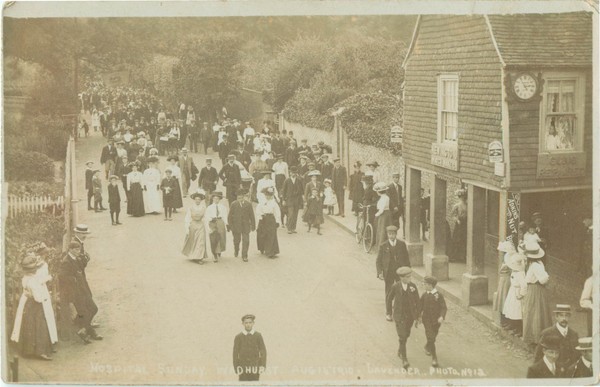Percy James Lavender

Hospital Sunday Procession in Wadhurst, August 1910. Looking west past Clock House towards The Walk
Photographer, Sparrows Green near Wadhurst in 1905, but by 1909 a newsagent in the High Street in Wadhurst. Percy Lavender was born on October 15, 1881, at Wadhurst, the youngest of nine sons of Julia and Henry Lavender, a general labourer. Julia had been born at Mayfield early in 1842, and Henry at Rotherfield in the summer of the same year. In 1891 the family were living in a house in Mark Cross Road in Wadhurst. Percy was still at school, but at least five of his older brothers, like his father, were agricultural labourers. When the 1901 census was held, he had enlisted as a Sapper with the Royal Engineers at Brompton Barracks in Gillingham.
Lavender is not listed in Kelly's 1905 Sussex Directory, which may mean he was still serving in the Army when the Directory was compiled. The Directory records, however, that one of his brothers (Walter Thomas Lavender) had given up working as an agricultural labourer to become a "builder, carpenter and joiner, wheelwright and coach painter" at Sparrows Green. Possibly Walter Thomas provided Percy with accommodation when he left the Army. In December 1905 Percy declared his address to be Sparrows Green when registering his copyright ownership and authorship of a photograph of hop-pickers.
Percy married Fanny Edith King on February 3, 1906, at the Wesleyan Chapel in Wadhurst. He stated that he was a photographer, living at 7 George Street in Sparrows Green. Fanny, who was a year older than Percy, lived at Brookfield at Wadhurst, and was the daughter of Henry King, an agricultural labourer.
On June 4, 1908, Wadhurst experienced a severe thunderstorm when hailstones the size of pigeon eggs fell on the village. Percy Lavender published at least two real photographic cards showing a plate piled with hailstones that someone had collected. The photographs have tended to fade badly, but appear to have been originally black and white, perhaps with a hint of sepia. They have narrow borders and captions written in backward-tilting block capitals. A later real photographic shows a parade at Wadhurst on Hospital Sunday, August 14, 1910. Also interesting is a real photographic of a minor landslip at neighbouring Best Beech Hill (1910 postmark seen).
Some real photographic cards lack captions and borders, but are stamped "Lavender, Photo, Wadhurst" on the back next to a tiny logo of a bellows-type camera.
Percy Lavender evidently found his work in Wadhurst unfulfilling because in May 1911 he sailed on the SS Teutonic to Quebec to start a new life in Canada. The ship's register lists him as a photographer/carpenter. His wife and children joined him in London, Ontario in the following year (she emigrated with Walter and his family). After settling in Canada, Percy Lavender seems to have made no further use of his photographic skills, concentrating instead on his carpentry work. He served as a member of the Canadian Overseas Forces in World War 1, fighting in Flanders in 1916. He suffered lung damage due to mustard gas and returned to Canada from Liverpool on the RMS Olympic in February 1918. He died in Canada in 1949, followed by Fanny ten years later in 1959. Their son, Henry James Lavender (1906 - 1998), was the only child to reach adulthood.
Several English members of the Lavender family continue to live in the Wadhurst area, which by happy coincidence has become an active centre for lavender farming.
Acknowledgement: Grateful thanks are due to Linda A. Lavender and Adrian Lavender (Percy's grandson) for correcting errors in an earlier version of this account and for supplying much useful additional information.
To directory of publishersTo gallery
Design: Lucid Design
© www.sussexpostcards.info
